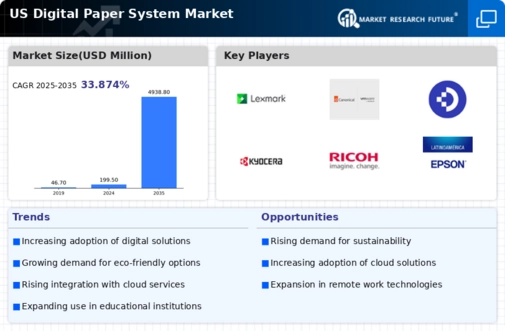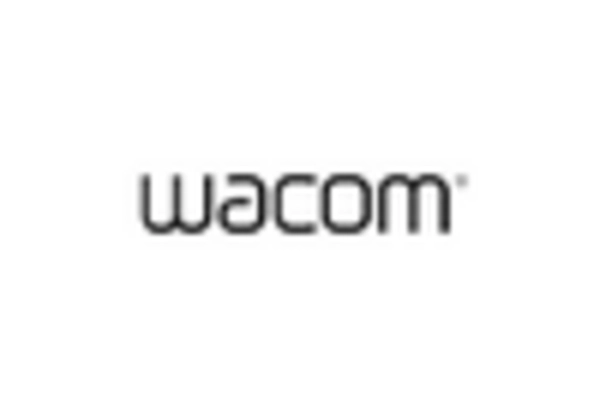The digital paper-system market is currently characterized by a dynamic competitive landscape, driven by rapid technological advancements and evolving consumer preferences. Key players such as Apple (US), Microsoft (US), and Wacom (JP) are at the forefront, each adopting distinct strategies to enhance their market positioning. Apple (US) continues to innovate with its iPad and Apple Pencil, focusing on seamless integration of hardware and software to create a cohesive user experience. Meanwhile, Microsoft (US) emphasizes its Surface line, which combines traditional computing with digital writing capabilities, thereby appealing to both creative professionals and business users. Wacom (JP), known for its high-quality stylus technology, is leveraging partnerships with software developers to expand its ecosystem, enhancing the functionality of its products in creative industries.
The business tactics employed by these companies reflect a concerted effort to optimize supply chains and localize manufacturing, which is particularly relevant in the context of fluctuating global trade dynamics. The market structure appears moderately fragmented, with a mix of established players and emerging startups vying for market share. This fragmentation allows for diverse offerings, yet the collective influence of major companies like Apple (US) and Microsoft (US) tends to dominate market trends and consumer expectations.
In October 2025, Apple (US) announced a significant upgrade to its iPad Pro, incorporating advanced display technology that enhances the digital writing experience. This move is strategically important as it not only reinforces Apple's commitment to innovation but also positions the iPad Pro as a leading tool for professionals in creative fields. The integration of improved display features is likely to attract a broader user base, further solidifying Apple's market presence.
In September 2025, Microsoft (US) unveiled a new version of its Surface Pen, which features enhanced pressure sensitivity and tilt functionality. This development is crucial as it aligns with the growing demand for precision in digital writing and drawing applications. By continuously refining its hardware, Microsoft (US) aims to maintain its competitive edge in the digital paper-system market, appealing to both artists and business professionals who require reliable tools for their work.
In August 2025, Wacom (JP) entered into a partnership with a leading graphic design software company to create a bundled offering that combines its stylus technology with advanced design tools. This strategic alliance is indicative of Wacom's focus on enhancing user experience and expanding its market reach. By integrating its products with popular software, Wacom (JP) is likely to attract new customers and reinforce its position as a leader in the digital art space.
As of November 2025, the competitive trends in the digital paper-system market are increasingly defined by digitalization, sustainability, and the integration of AI technologies. Strategic alliances among key players are shaping the landscape, fostering innovation and enhancing product offerings. Looking ahead, it is anticipated that competitive differentiation will evolve, shifting from price-based competition to a focus on technological innovation, user experience, and supply chain reliability. This transition underscores the importance of adaptability and forward-thinking strategies in a rapidly changing market.

















Leave a Comment